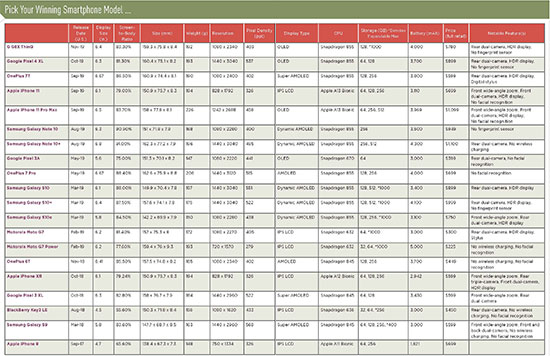
This is the sixth annual State Bar of Wisconsin summary of the best currently available smartphones. As is the case every year, the options and features continue to improve and expand. Manufacturers seemed to focus on improving the quality and quantity of cameras this year, in addition to the usual enhancements to performance and screen size. Whether you are a member of team iPhone or team Android, there are amazing phones to consider on the high end of the pricing scale as well as those for the more budget-conscious consumers.
Speaking of the debate between iPhone and Android, most experts recommend sticking with what you know, rather than making a switch. If you are used to the more customizable experience of Android, you might find iOS restrictive and frustrating. If you like the user experience and frequent updates of iOS, you may find Android customization options overwhelming. It is rare to find an app today that is not made for both operating systems. The one difference lawyers may be particularly interested in is that more malware (malicious software) is written for Android systems than iOS. Some Android phones allow for storage expansion, though there are multiple ways to back up or store documents, images, and more in the cloud as an alternative to using storage space in the hardware itself.
 Aly Lynch, Marquette 2007, has retired from her first career in law firm management and presently works as a virtual assistant and marketing manager. She continues her love of technology with the writing and related research for this article as well as developing her skills in various coding languages for website and mobile app development. She is a previous chair of the State Bar of Wisconsin Law Office Management Assistance Program (Practice411™) Advisory Committee.
Aly Lynch, Marquette 2007, has retired from her first career in law firm management and presently works as a virtual assistant and marketing manager. She continues her love of technology with the writing and related research for this article as well as developing her skills in various coding languages for website and mobile app development. She is a previous chair of the State Bar of Wisconsin Law Office Management Assistance Program (Practice411™) Advisory Committee.
After several years using one operating system, I made the switch myself in March 2018. I was excited to try the smartphone I had been in love with since I started research for this article a few years ago. It was a fantastic smartphone and I am glad that I tried it, but in April 2019, I switched back to a smartphone with my original operating system. In my experience, the experts are correct: I probably should have stuck with what I was used to.
Wireless phone service providers continue to offer smartphones for purchase with monthly payments at zero-interest financing over two to three years or for the full price at the outset. Monthly payments of $10-60 seem more palatable than $240-1,100 all at once. You can usually get a few hundred bucks or more off the price with a decent trade-in.
As usual, service coverage will depend on where you primarily spend your time and travel. If you tend to use little data because you are often on a Wi-Fi network at home or in the office, a virtual carrier with lower service costs may suit your needs. At the other end of the spectrum, regular international travelers will need to be aware not only of service but also of hardware capabilities of the phone itself. Larger service providers tend to offer a wider array of manufacturers and models, but you may be able to buy a particular model from another retailer and still use it on your network, even if they don’t sell that model directly. Check with the service provider to confirm service capabilities.
Not all of the top-rated smartphones are found on this year’s list. Phones from Chinese manufacturers such as Huawei and Xiaomi are not sold by major service providers in the United States, mainly because of security concerns. Some common manufacturers were left off the list because reviews were lower this year or because they simply didn’t stand out in terms of unique features or overall power. This article focuses on the most common smartphone manufacturers and models with good ratings from reputable review websites and provided by the major U.S. service carriers.
Changes for 2020
The smartphone features most often touted this year relate again to camera quality and quantity as well as increased performance, speed, and screen size. Folding, two-screen smartphones have recently been introduced in the market, but the reviewers and early user problems indicate that it might still be too soon to buy into this technology. Manufacturers are just coming out with smartphones capable of super-fast 5G speeds but, other than T-Mobile, the 5G networks currently don’t come closer to Wisconsin than the Chicago area.
Photography experts will want to dive deeper into the specifications than what this article provides, as there is much more to a great camera than the number of megapixels. For the typical user, however, photo-snapping happiness can be found with any of these phones. The quality of the images and video, the array of optional effects, and the ease of editing and sharing are all things plain cameras couldn’t do 10 years ago. This year we see the advent of the smartphone with four rear cameras for taking wide, ultrawide, telephoto, and time-of-flight pictures.
Processors continue to improve the speed of smartphones and overall performance. The iPhones went from the Apple A12 CPU last year to the Apple A13, and nearly all of the Androids on this list have the Snapdragon 855. The computing power of these phones is better than most laptops today. Smartphone batteries continue to improve as well. Non-iPhones historically have longer battery life, but even the latest iPhones will now get you through the day without a need to charge, with normal use.
Smartphone sizes have remained about the same because bigger phones are heavier and harder to hold and pocket. So the screen-to-body ratio has increased by narrowing the bevel (screen frame) and employing a notch (for the camera and receiver). A screen-to-body ratio of 87 percent or more is excellent.
The two major smartphone display types are AMOLED and IPS LCD. They each have advantages and disadvantages, and the differences between the two have changed over the years and will continue to change. Major manufacturers put their own proprietary technologies in their displays, so two different AMOLED smartphone displays, for example, might not look the same. AMOLED is generally better than LCD, Super AMOLED is even better, and Dynamic AMOLED is Super AMOLED with HDR10+ certification. Most people will find that these displays are all amazing and will be better than the display on a phone bought two years ago.
More phones on this year’s list have facial recognition than don’t. Many of the phones have fingerprint scanners. A few phones on this list also have iris scanners, which are the most accurate biometrics. Even identical twins have different iris patterns. You can still use a passcode or pattern to unlock the phones, log in to protected apps, and pay for purchases. So if you are nervous about the security of using biometrics for these activities, you can disable them.
For a side-by-side comparison of some of the main specs on the latest smartphones, see the accompanying table. The average smartphone on this list has a 6.2-inch screen, 443 pixels per inch, 82 percent screen-to-body ratio, and weighs 181 grams (6.4 ounces).

(Click on the image to view larger version)
The Field: Pricey
Apple iPhone 11 Pro Max ($1,099) – Best smartphone on the market.
Samsung Galaxy S10+ ($999) – Best Android on the market.
Samsung Galaxy Note 10+ ($1,100) – Best big-screen phone; great for artists and note-takers.
Google Pixel 4 XL ($899) – Smartest camera on the market and great performance.
The Field: Mid-Range Budget
Samsung Galaxy S10e ($750) – Best overall price, performance, and size for a major-brand smartphone.
OnePlus 7 Pro ($669) – Best Android value for the money; has a pop-up selfie camera to maximize screen space.
Apple iPhone 11 ($699) – Less expensive, great iPhone.
The Field: Frugal
Google Pixel 3A ($399) – Best Android under $400.
Motorola Moto G7 Power ($225) – Longest battery life; solid performance.
Blackberry Key2 LE ($450) – Actual keyboard; productivity powerhouse.
Last Year’s Top Models
Just because they came out in 2018 (or 2017) doesn’t mean they’re obsolete by any means. Phones like the OnePlus 6T, the iPhone 8 and XR, the Google Pixel 3 and 3 XL, and the Samsung Galaxy S9 and S9+ are still really good phones and, with reduced prices, remain competitive. Many reviews still put these phones in the top 20 smartphones now available.
Wrap Up
Overall, the iPhone XS and XS Max, the Samsung Galaxy Note 9, and the Google Pixel 3 and 3 XL are arguably the “best” smartphones currently available, but that doesn’t necessarily mean they are the best for you. If you have specific features, functionality, or specifications you prefer, you’ll want to investigate further: there are additional options out there. For most people, though, and based on the reviews of present users and experts, these are the best smartphones currently available. And unless you’re very particular about your gadgets, having a nice, new, fast phone is always exciting.
